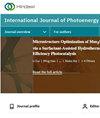利用反问题法研究垂直余热回收的气固传热特性
IF 2.1
4区 工程技术
Q3 CHEMISTRY, PHYSICAL
引用次数: 1
摘要
为了建立精确的模型来优化烧结矿垂直冷却过程,采用反问题法计算基于出口温度的气固换热系数,并将其拟合到关联关系中。研究表明,气速的增大有利于气固换热的增强。当气速u g由0.8 m·s-1增加到1.6 m·s-1时,换热系数h v增加了约2倍。但这种效应会随着粒径的增大而减弱。此外,颗粒尺寸的减小有利于提高气固之间的对流换热强度。随着粒径的减小,这种增强效应逐渐明显。当u = 0.8 m·s-1时,当粒径从20~25 mm减小到15~20 mm时,h v增大幅度为1142.25 W·m-3·K-1;当粒径从15~20 mm减小到10~15 mm时,h v增大幅度为3152.65 W·m-3·K-1。此外,努塞尔数的实测值随雷诺数的变化趋势与其他著作的预测值相同。然而,在数值上有相当大的偏差。其中,平均相对误差最小值为26.81%。结果表明,以往的经验相关性不再适用,而本工作的预测值与实测值吻合较好,平均偏差仅为7.61%。因此,修正后的关联关系可以准确预测烧结床内的气固换热特性,为新工艺的数值设计和优化奠定了基础。本文章由计算机程序翻译,如有差异,请以英文原文为准。
Experimental Study on Gas-Solid Heat Transfer Characteristics for the Vertical Waste Heat Recovery Using the Inverse Problem Method
To establish an accurate model to optimize the vertical cooling process of the sinter, the inverse problem method is used to calculate the gas-solid heat transfer coefficient based on the gas outlet temperature, which is fitted into the correlation. The research indicates that the increase in the gas velocity is beneficial to the enhancement of the gas-solid heat transfer. With the gas velocity
u
g
increasing from 0.8 m·s-1 to 1.6 m·s-1, the heat transfer coefficient
h
v
increases by about twice. But this effect will weaken with the increase in the particle size. Besides, the reduction of the particle size is conducive to improving the convective heat transfer intensity between the gas and solid. With the particle size decreasing, this enhancement effect is progressively evident. At
u
g
of 0.8 m·s-1, the increasing extent of
h
v
is 1142.25 W·m-3·K-1 with the particle size decreasing from 20~25 mm to 15~20 mm, while that is 3152.65 W·m-3·K-1 with the particle size decreasing from 15~20 mm to 10~15 mm. In addition, the variation of the measured value of the Nusselt number with the Reynolds number has the same trend as predicted values obtained by other works. However, there is a considerable deviation in the value. Among them, the minimum value of the mean relative error is 26.81%. It is proved that the previous empirical correlations are no longer applicable, while the predicted value of this work is in good agreement with the measured value with the mean deviation of only 7.61%. Therefore, the modified correlation can accurately predict the gas-solid heat transfer characteristics in the sinter bed, which lays a foundation for the numerical design and optimization of the new process.
求助全文
通过发布文献求助,成功后即可免费获取论文全文。
去求助
来源期刊
CiteScore
6.00
自引率
3.10%
发文量
128
审稿时长
3.6 months
期刊介绍:
International Journal of Photoenergy is a peer-reviewed, open access journal that publishes original research articles as well as review articles in all areas of photoenergy. The journal consolidates research activities in photochemistry and solar energy utilization into a single and unique forum for discussing and sharing knowledge.
The journal covers the following topics and applications:
- Photocatalysis
- Photostability and Toxicity of Drugs and UV-Photoprotection
- Solar Energy
- Artificial Light Harvesting Systems
- Photomedicine
- Photo Nanosystems
- Nano Tools for Solar Energy and Photochemistry
- Solar Chemistry
- Photochromism
- Organic Light-Emitting Diodes
- PV Systems
- Nano Structured Solar Cells

 求助内容:
求助内容: 应助结果提醒方式:
应助结果提醒方式:


